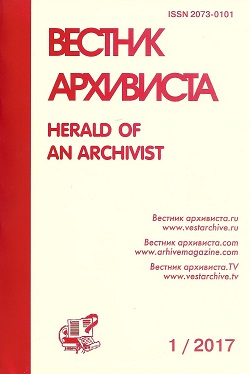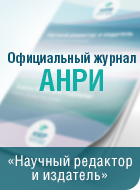Scientific article
doi 10.28995/2073-0101-2024-3-749-765
For citation
Mazur, Lyudmila N., Khor'kova, Vera M. (2024), Passports of cities of 1954 as a historical source: information potential and methods of research, Herald of an Archivist, № 3, pp. 749-765, doi 10.28995/2073-0101-2024-3-749-765
Mazur, Lyudmila N., Khor'kova, Vera M., Ural Federal University named after the First President of Russia B. N. Yeltsin, Ekaterinburg, Russian Federation
City passports of 1954 as a historical source: information potential and methods of study
Abstract
To characterize the processes of urbanization at the regional and local level, passports of cities are of great interest. In particular, the State Archive of the Sverdlovsk Oblast (GASO) preserved passports of cities of the Sverdlovsk Oblast, a total of 62 forms filled out in 1954-1960. The purpose of the article is to characterize the information potential of the city passport for the study of urbanization processes. The article considers the information structure of the passport, sources of information used for its filling, assesses the completeness and reliability of the information presented in the passport. The methodology of studying passports using database technology is proposed. The city passport “Main indicators of economic and cultural development” is a statistical source containing dynamic series (from the beginning of the XX century to 1960) of summary indicators of city development - population, industry, trade, construction, transportation, landscaping and others. The passport form was approved by the Central Statistical Service of the USSR in 1954 and consisted of an album-size notebook reproduced by printing. The passport was compiled by the staff of the rayon inspectorates and submitted to the sector of consolidated balance works of the regional Statistical Department. The sector was established in the second half of 1953 and was engaged in the preparation of consolidated data on the development of the national economy of the oblast, its cities and districts. By its origin the passport refers to secondary documents, in which the accounting and calculation information, obtained in the process of one-time and permanent statistical observations, was recorded. In the structure of the form 13 thematic sections (45 tables) can be distinguished: General information; Territory; Population; Number of workers and employees; Industry; Transportation and communication; Housing stock; External improvement of the city; Cultural construction; Health and physical education; Commodity turnover; Utilities; Execution of the city budget. The passport form opens with detailed instructions for its completion, indicating the sources of information and algorithms for calculating indicators for each section. The sources of information were reports of enterprises and institutions, materials of numerous special censuses and surveys conducted by statistical authorities in the 1930s-1940s, as well as official resolutions and directories, and archival documents. Control measures increased the reliability of passport data. Reflecting in retrospect the dynamics of the main indicators of the city's development, the passport, of course, had a practical value and was attracted as an information resource in solving the problems of long-term planning.
Keywords
City passport, historical source, statistics, database, USSR, Soviet city, urban industry, population, urban environment.
Download the article: mazur_khorkova
References
Argunov, S. V., Kogan, Y. V., Nazarov, M. N., Starostina, N. G. (2019), Passport of the city as a tool of territorial planning, Public Service, № 5, pp. 68-75.
Bakanov, S. A. (2017), Demographic degradation of cities in the old industrial areas of the Urals (1959-2010), Quaestio Rossica, № 5 (1), pp. 74-85.
Bakanov, S. A. (2005), Depressive cities of the Urals in 1960-1980s: Analysis of socio-economic and demographic factors, ChelSU, Chelyabinsk, Russia, 191 p.
Bakanov, S. A. (2002), Experience in creating an electronic database “Depressive cities of the Urals in 1970-80-ies”, Newsletter of the Association “History and Computer”, № 30, pp. 179-181.
Blum, A., Mespoulet, M. (2006), Bureaucratic anarchy: statistics and power under Stalin, ROSSPEN, Moscow, Russia, 328 p.
Borodkin, L. I. (2015), Historian in the world of computer technologies: spiral development?, Electronic scientific and educational journal “History”, vol. 6, № 8 (41), http://history.jes.su/s207987840001263-8-1 (date of address 18.03.2024).
Garskova, I. M. (2019), “Digital turn” in historical research: long-term trends, Historical Informatics, № 3, pp. 57-75. https://nbpublish.com/library_read_article.php?id=312511 (date of address 13.03.2024).
Dumchikov, A. A. (2023), Development of the general plan of Sverdlovsk in the 1930s: problems and peculiarities, Ural Historical Bulletin, № 3 (80), pp. 37-44.
Eliseeva, I. I., Dmitriev, A. L. (2016), Essays on the history of state statistics in Russia, Rostock, St. Petersburg, Russia, 288 p.
Pentsev, E. A. (2016), General plan of the city: textbook, Bulavina L. V. (ed.), Ural. un-t, Yekaterinburg, Russia, 62 p.
Alkhoven, P., Doorn, P. (2007), New Research Perspectives for the Humanities, International Journal of Humanities and Arts Computing, vol. 1, № 1. pp. 35–47.
Thaller, M. (2012), Controversies around the Digital Humanities: An Agenda, Historical Social Research. Special Issue: Digital Humanities, vol. 37, № 3, pp. 7–22.
About the authors
Mazur Lyudmila N., Doctor of Historical Sciences, Associate Professor, Ural Federal University, Ural Institute for the Humanities, Department of Document, Archival and Public Administration History, Head of Department, Ekaterinburg, Russian Federation, 8-922-202-73-69, This e-mail address is being protected from spambots. You need JavaScript enabled to view it
Khor'kova Vera M., Ural Federal University, Ural Institute for the Humanities, Department of History, student, Ekaterinburg, Russian Federation, This e-mail address is being protected from spambots. You need JavaScript enabled to view it
Grant information
The research was financially supported by the Russian Science Foundation, project № 24-28-00629 “Trajectories of development of the Middle Urals cities in the middle of the XX century: methodological and source research aspects”, https://rscf.ru/project/24-28-00629/
The article was received in the editorial office on 13.04.2024, recommended for publication on 20.06.2024.














